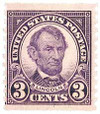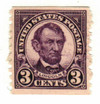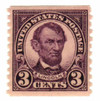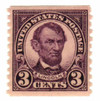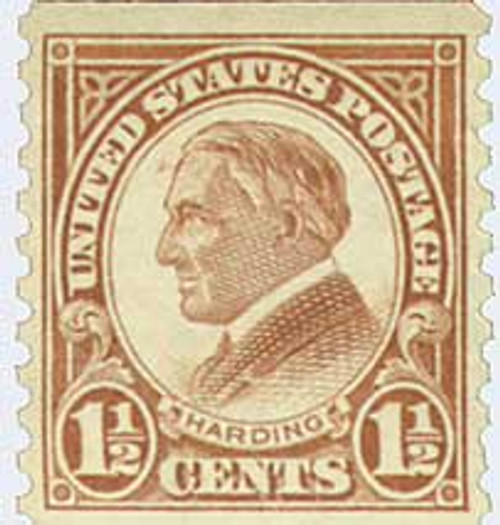
1924 3c Lincoln, coil, perf 10 vertical
# 600 - 1924 3c Lincoln, coil, perf 10 vertical
$0.35 - $42.50
U.S. #600
1923-29 Rotary Coil
3¢ Lincoln
1923-29 Rotary Coil
3¢ Lincoln
Issue Date: May 10, 1924
First City: Washington, DC
Issue Quantity: 499,091,500
Wheels of Progress
In 1847, when the printing presses first began to move, they didn’t roll – they “stamped” in a process known as flat plate printing. The Regular Series of 1922 was the last to be printed by flat plate press, after which stamps were produced by rotary press.
By 1926, all denominations up to 10¢ – except the new ½¢ – were printed by rotary press. For a while, $1 to $5 issues were done on flat plate press due to smaller demand.
U.S. #600 reproduces the design of U.S. #555 of the Series of 1922-25, which had been produced by flat plate printing.
The Lincolns of Kentucky
Abraham Lincoln is most often remembered for his connections to Illinois; however, the Lincoln family had its roots in Kentucky.
Among Kentucky’s first pioneers was Abraham Lincoln (1744-86), a captain of militia during the American Revolution and the namesake of his grandson, future President Abraham Lincoln. In 1780, Lincoln sold his Pennsylvania farm and moved his young family to an area east of Louisville, Kentucky, that was still claimed by Indians who lived across the nearby Ohio River. As was customary, the Lincolns settled near a frontier fort, called stations, for protection during conflicts between settlers and Indians.
In 1786, Lincoln was attacked and killed by an Indian “when he was laboring to open a farm in the forest.” His eldest son ran to the cabin for a gun while the middle son ran to the station for help. Immobilized by fear, the youngest son Thomas stood by his father as the attacker moved closer. His older brother was able to shoot the attacker and kill him, saving Thomas’ life.
With a widowed mother and four underage siblings, Thomas Lincoln (1778-1851) received little schooling and went to work at a young age. Following his 1806 marriage to Nancy Hanks, Thomas bought a 300-acre farm in Nolin Creek, Kentucky. The couple’s second child, Abraham Lincoln, was born in the cabin on Sinking Spring Farm in 1809.
Active in community and church affairs, Thomas worked as a country prisoner guard and carpenter. In spite of his relative affluence, the Lincoln’s lost three properties due to defective land titles that plagued Kentucky’s early settlers. Frustrated by the losses, Thomas Lincoln moved his family to Indiana in 1816. Years later, President Abraham Lincoln attributed the move “partly on account of slavery, but chiefly on account of the difficulty of land titles in Kentucky.”
President Abraham Lincoln was the first American president to be born outside of the original thirteen colonies. In 1909, President Theodore Roosevelt laid the cornerstone for a national park at the site of Abraham Lincoln’s birthplace in Nolin, Kentucky. A replica of the log cabin he was born in graces the property.
U.S. #600
1923-29 Rotary Coil
3¢ Lincoln
1923-29 Rotary Coil
3¢ Lincoln
Issue Date: May 10, 1924
First City: Washington, DC
Issue Quantity: 499,091,500
Wheels of Progress
In 1847, when the printing presses first began to move, they didn’t roll – they “stamped” in a process known as flat plate printing. The Regular Series of 1922 was the last to be printed by flat plate press, after which stamps were produced by rotary press.
By 1926, all denominations up to 10¢ – except the new ½¢ – were printed by rotary press. For a while, $1 to $5 issues were done on flat plate press due to smaller demand.
U.S. #600 reproduces the design of U.S. #555 of the Series of 1922-25, which had been produced by flat plate printing.
The Lincolns of Kentucky
Abraham Lincoln is most often remembered for his connections to Illinois; however, the Lincoln family had its roots in Kentucky.
Among Kentucky’s first pioneers was Abraham Lincoln (1744-86), a captain of militia during the American Revolution and the namesake of his grandson, future President Abraham Lincoln. In 1780, Lincoln sold his Pennsylvania farm and moved his young family to an area east of Louisville, Kentucky, that was still claimed by Indians who lived across the nearby Ohio River. As was customary, the Lincolns settled near a frontier fort, called stations, for protection during conflicts between settlers and Indians.
In 1786, Lincoln was attacked and killed by an Indian “when he was laboring to open a farm in the forest.” His eldest son ran to the cabin for a gun while the middle son ran to the station for help. Immobilized by fear, the youngest son Thomas stood by his father as the attacker moved closer. His older brother was able to shoot the attacker and kill him, saving Thomas’ life.
With a widowed mother and four underage siblings, Thomas Lincoln (1778-1851) received little schooling and went to work at a young age. Following his 1806 marriage to Nancy Hanks, Thomas bought a 300-acre farm in Nolin Creek, Kentucky. The couple’s second child, Abraham Lincoln, was born in the cabin on Sinking Spring Farm in 1809.
Active in community and church affairs, Thomas worked as a country prisoner guard and carpenter. In spite of his relative affluence, the Lincoln’s lost three properties due to defective land titles that plagued Kentucky’s early settlers. Frustrated by the losses, Thomas Lincoln moved his family to Indiana in 1816. Years later, President Abraham Lincoln attributed the move “partly on account of slavery, but chiefly on account of the difficulty of land titles in Kentucky.”
President Abraham Lincoln was the first American president to be born outside of the original thirteen colonies. In 1909, President Theodore Roosevelt laid the cornerstone for a national park at the site of Abraham Lincoln’s birthplace in Nolin, Kentucky. A replica of the log cabin he was born in graces the property.



